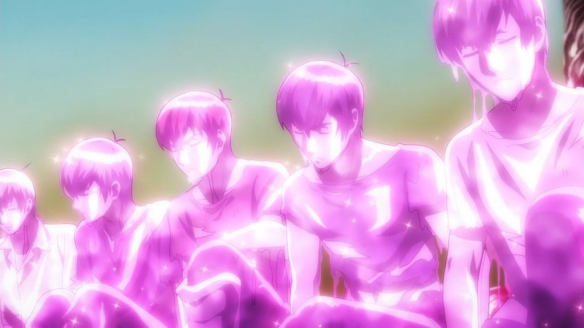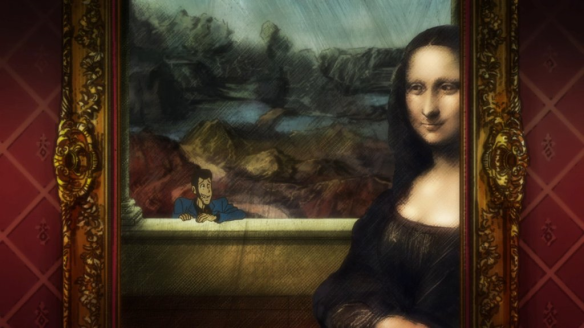
Part 2 of my countdown of the Winter 2016 season.
6. Osomatsu-san

I originally dropped Osomatsu-san early on, having loved the grand parody of the first episode but fearing the slightly morose and topical references during the follow up indicated a heavy shift into cringe-based humour and angry societal sermonising. It was only after enough people I trust and seemingly the entire fujoshi fandom started making recommendations that I gave it another chance and found a far more relaxed, if completely absurd comedy than expected.
That’s not to say there isn’t a mean-spirited edge to the material or that some of the sketches are pretty uncomfortable to watch, but it never turned into one of those excruciating British comedies like The Office or The Inbetweeners that cause the skin to crawl right off my bones. The core cast might be a bunch of losers and sociopaths (and whatever the fuck is wrong with Jyushimatsu), but the tone is generally upbeat enough to prevent things from becoming morose. Even at their most obnoxious the brothers still have enough charm to stop you despising them. Coming from someone who couldn’t stomach the likes of Watamote or Turing Girls, it’s a huge relief.
Of course, being 26 episodes worth of assorted sketches means that the overall quality also varies quite a bit, which isn’t much of an issue for 2-3 minute gags but when some scenes take up to half an episode it can quickly turn into a chore. Fortunately I found few real stinkers, only despising the Anpanman parody shorts (although I generally liked the cast enough that an entire twenty-four minutes of Iyami screaming “Sheeh!” would have been fine), so it never turned into a situation of skipping through the episodes to get to the good parts like with Nichijou. The sketch format also allows room to experiment every now and again, either in animation shifts such as the bishounen segments or with some of the random abstract pieces like Dekapan and Dayun’s surrealist trip across America. Sure, it’s hardly going to give Space Dandy a run for its money, but at least you can tell the staff had some freedom to play around as they pleased.
5. Lupin the Third (part 4)

It’s a real shame that a combination delayed streaming and unfamiliarity with the Lupin franchise amongst newer fans meant that this never received the exposure it deserved, as the end result was spectacularly goofy entertainment. After all the shows attempting big, all-encompassing story arcs this season, having a light and breezy episodic yarn was a real breath of fresh air.
I’ll admit to being largely unfamiliar to Lupin, other than watching the spin-off The Woman Called Fujiko Mine back in 2012, but the weekly antics of the master thief and his various cohorts hardly needs much in the way of introduction. This adaptation takes the gorgeous Redline-esque visual style of Fujiko Mine, but keeps the tone of the mainstream iterations rather than the overly gritty/sleazy subject matter of the former. As someone who balked at the writing in that show, which often felt like an attempt at a ‘mature’ and ‘edgy’ drama by people too used to making shows for the teenage market, I definitely appreciated an approach that wasn’t trying so hard.
The end result is a story that knows exactly when to be silly and ridiculous in its ideas without ever losing all sense of narrative, and even though the episodic nature allows it to constantly segue across genres, the heart of the show remains rooted around the rough but loveable cast, so the tone never felt discordant or exploitative like Fujiko Mine did during bleaker subject matter. Honestly the only part I wasn’t taken with was shoehorning in an end villain during the second half. I can’t say whether this has been an issue for previous iterations but while introducing an overarching conflict was never enough to derail the momentum, the overall style of Lupin, like the man himself, performs better when free of baggage.
So yeah, if you preferred the parts of Fujiko Mine that had Goemon slicing up bombs on top of a bi-plane in order to stop the Cuban Missile Crisis, or Fujiko imitating Maria from The Sound of Music as part of a con, then this will probably be up your street. And if you’re new to the franchise, it’s as good a place to start than any.
4. Haikyu!!

Another season down, which means another example of how to successfully pull off a top notch sports series without overlying on gimmicks. Haikyu!! remains a solid example of getting the formula right by balancing the personal struggles with the actual matches. It rarely attempts anything outlandishly creative or leftfield, instead using top notch animation and an effective use of music to bolster its simple, but solidly executed story. It may be more of the same, but having already introduced the core cast allows the show to spend more time on the games, while interspersing the character moments in between. While season two is slower paced it’s also more deliberate and intense, starting off with a series of training matches, which allow for the improvement of individual techniques prior to the spring tournament. There’s a continuous rising action all the way through, culminating in the highlight multi-episode match against Aoba Jousai, which represents the meat of the show.
Aoba Jousai is easily the main reason why this arc is so successful, having already been established as a powerful threat during season one. Oikawa’s personality and influence on the match manages to suck every other player into his field of influence and every move Karasuno musters ends up a counterattack against his mind games and team bolstering abilities. Despite being the opposition, he remains the most fascinating character in the show, making it difficult not to root for him rather than the protagonists. Waiting the entire season for this revenge match continuously ramps up the stakes further, with the climax using every trick up the show’s sleeves to create a genuinely thrilling and unpredictable game.
That said, this arc will likely make the already announced final season a tough act to follow, now that the focus is on beating Shiratorizawa Academy. There have been attempts made to portray Ushijima as the ultimate challenge but so far he comes across a less impressive or interesting rival as Oikawa did. It’s like the difference between a fight against your nemesis in a jrpg and the generic final boss that shows up out of nowhere. Hopefully S3 will make me eat my words but I remain doubtful.
